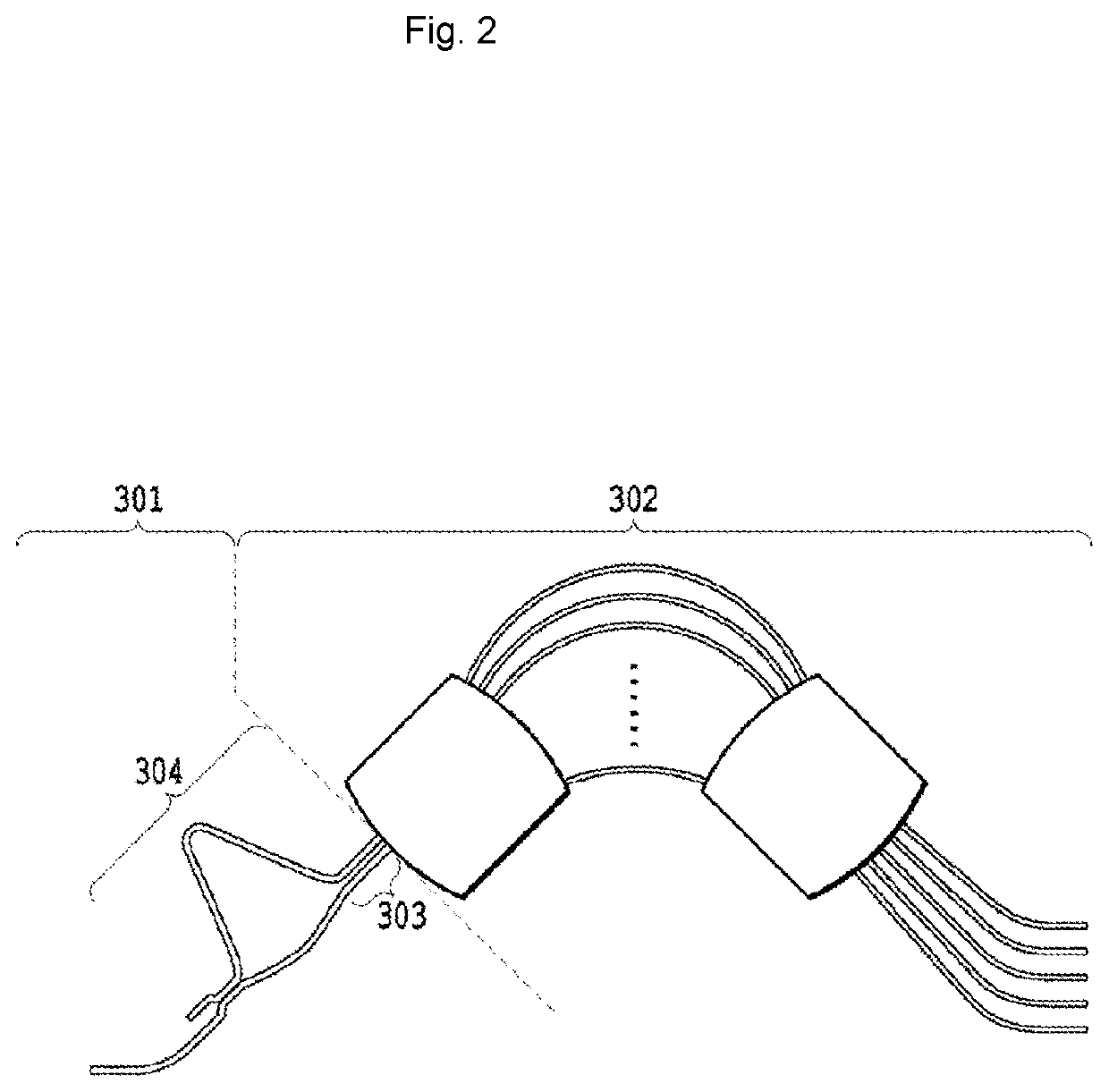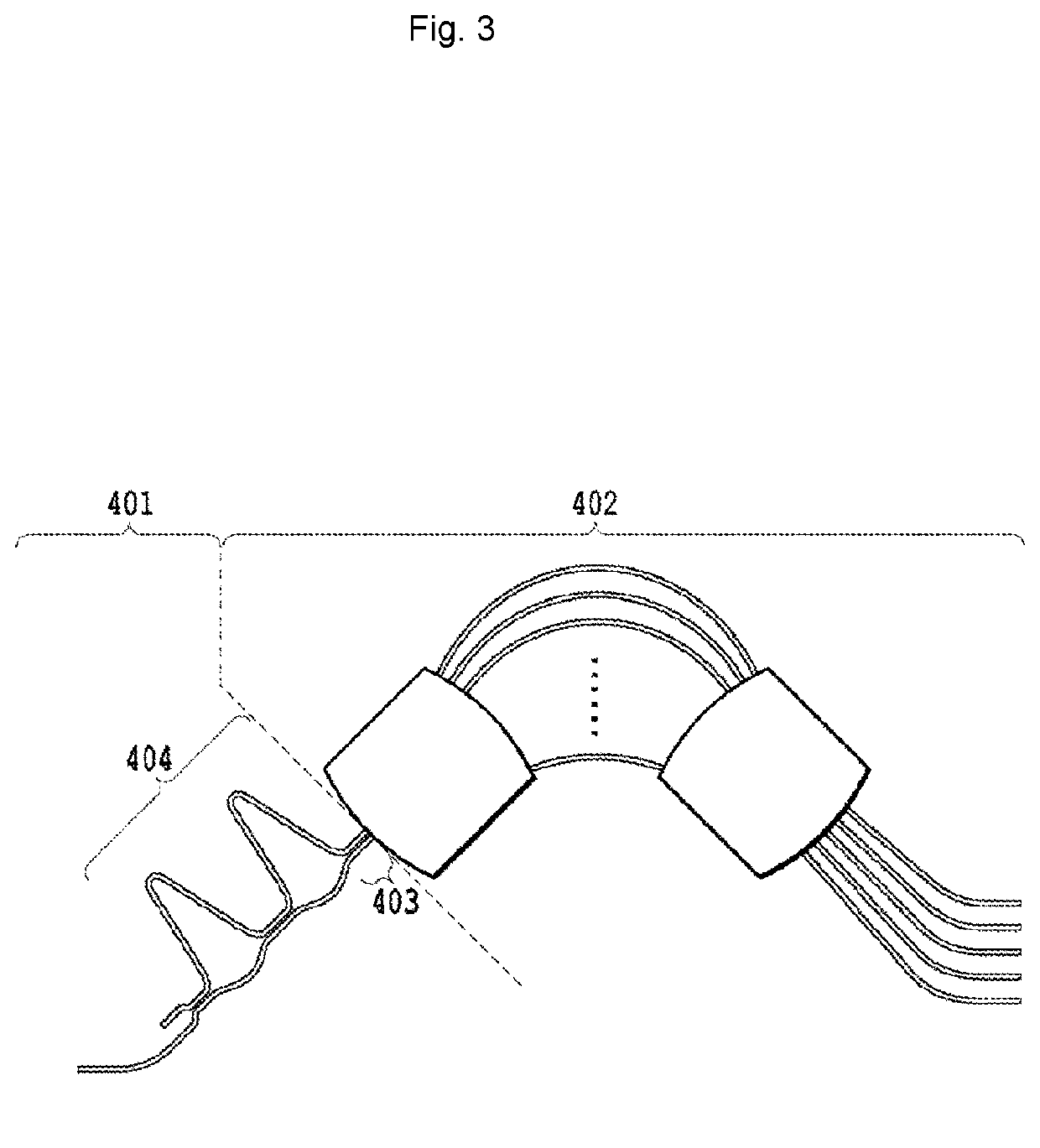Optical Multi/Demultiprexing Circuit
a multi-prexing circuit and optical technology, applied in the field of optical wavelength multi-prexing circuits, can solve the problems of increasing loss, increasing variation (ripple) of transmission loss, and difficulty in achieving stable manufacturing
- Summary
- Abstract
- Description
- Claims
- Application Information
AI Technical Summary
Benefits of technology
Problems solved by technology
Method used
Image
Examples
embodiment 1
[0109]FIG. 17 is a schematic view showing the basic configuration of an optical wavelength multi / demultiplexing circuit 10A according to embodiment 1 of the present invention.
[0110]As shown in FIG. 17, the optical wavelength multi / demultiplexing circuit 10A according to embodiment 1 of the present invention is constituted by coupling an AWG (Arrayed Waveguide Grating) 102 designed with wavelength channel spacing of 100 GHz and a field modulation device 101 having an optical frequency repetition period (FSR) of 100 GHz.
[0111]Of these, the field modulation device 101 is constituted by a common input waveguide 103, an optical branching unit 108, four optical delay lines 104, 105, 106 and 107, a multiplex interference unit 112, and a mode converter / multiplexer 115. Also, the optical branching unit 108 is constituted by a first optical branching element 109 with a branching ratio of 12%, a second optical branching element 110 with a branching ratio of 70%, and a third optical branching e...
embodiment 2
[0124]FIG. 20 is a schematic view showing the basic configuration of an optical wavelength multi / demultiplexing circuit 10B according to embodiment 2 of the present invention.
[0125]As shown in FIG. 20, the optical wavelength multi / demultiplexing circuit 10B according to embodiment 2 of the present invention is constituted by coupling an AWG (Arrayed Waveguide Grating) 2602 designed with wavelength channel spacing of 100 GHz and a field modulation device 2601 having an optical frequency repetition period (FSR) of 100 GHz.
[0126]Of these, the field modulation device 2601 is constituted by a common input waveguide 2603, an optical branching element 2608, four optical delay lines 2604, 2605, 2606 and 2607, a multiplex interference unit 2612, and a mode converter / multiplexer 2615. The optical branching unit 2608 is constituted by a first optical branching element 2609 with a branching ratio of 15% and a second optical branching element 2610 and a third optical branching element 2611 with ...
embodiment 3
[0142]FIG. 24 is a schematic view showing the basic configuration of an optical wavelength multi / demultiplexing circuit 10C according to embodiment 3 of the present invention.
[0143]Referring to FIG. 24, the optical wavelength multi / demultiplexing circuit 10C according to embodiment 3 of the present invention is constituted by coupling an AWG (Arrayed Waveguide Grating) 2902 designed with wavelength channel spacing of 200 GHz and a field modulation device 2901 having an optical frequency repetition period (FSR) of 200 GHz.
[0144]Of these, the field modulation device 2901 is constituted to include a common input waveguide 2903, an optical branching unit 2909, and five optical delay lines 2904, 2905, 2906, 2907 and 2908. Also, the field modulation device 2901 includes a multiplex interference unit 2914 and a mode converter / multiplexer 2917. The optical branching unit 2909 is constituted by a first optical branching element 2910 with a branching ratio of 46%, a second optical branching e...
PUM
 Login to View More
Login to View More Abstract
Description
Claims
Application Information
 Login to View More
Login to View More - R&D
- Intellectual Property
- Life Sciences
- Materials
- Tech Scout
- Unparalleled Data Quality
- Higher Quality Content
- 60% Fewer Hallucinations
Browse by: Latest US Patents, China's latest patents, Technical Efficacy Thesaurus, Application Domain, Technology Topic, Popular Technical Reports.
© 2025 PatSnap. All rights reserved.Legal|Privacy policy|Modern Slavery Act Transparency Statement|Sitemap|About US| Contact US: help@patsnap.com



